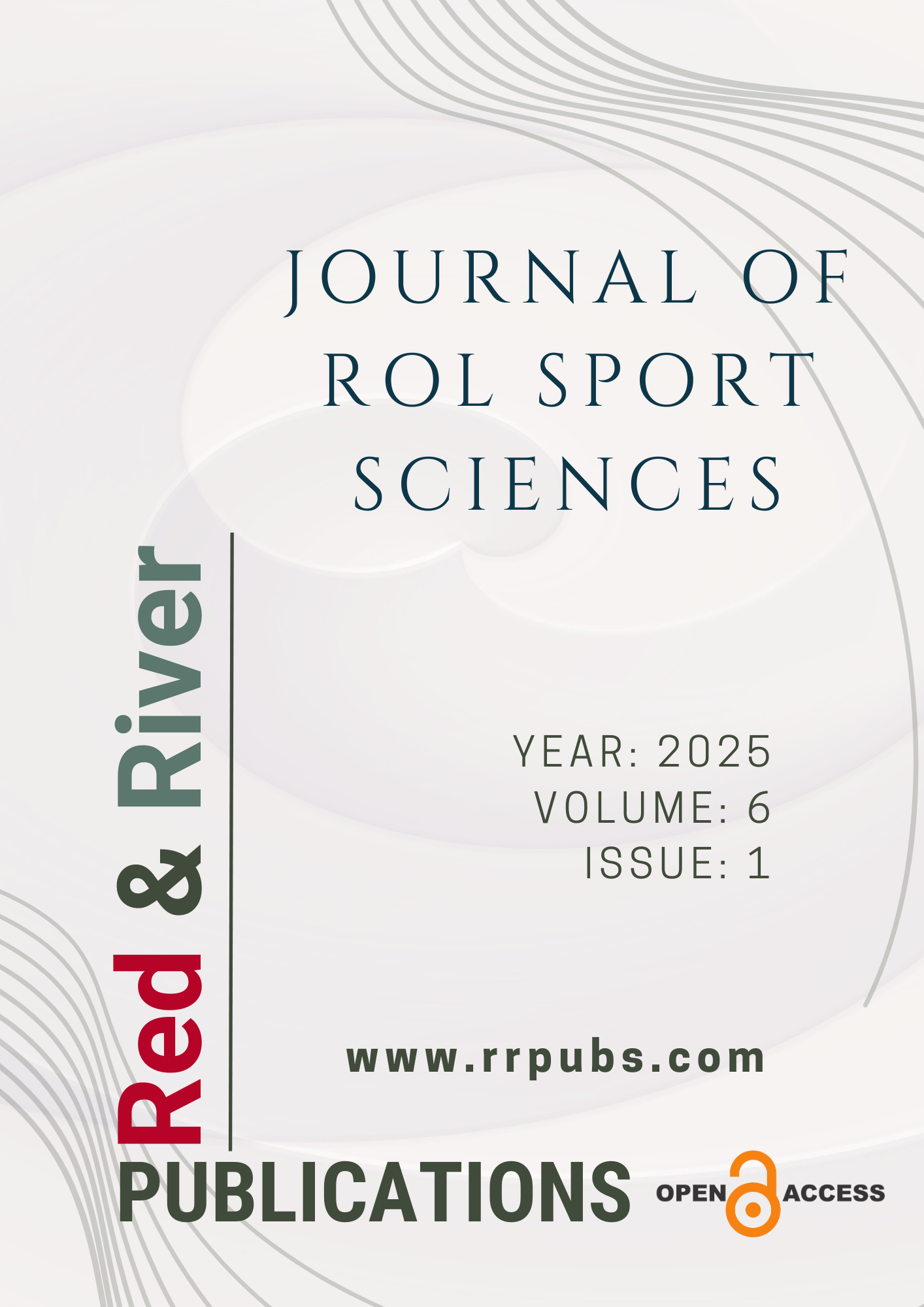Examining the relationship between team identification levels of university students who are team supporters and their attitudes towards team sponsors and their perceptions of causality
DOI:
https://doi.org/10.70736/jrolss.480Keywords:
Identification, Sponsorship, SportsAbstract
The aim of this research is to examine the relationship between team identification levels of university students who are team supporters and their attitudes towards team sponsors and their perceptions of causality. The method of the research is “Correlational Research” and according to the results of this research, the existing situations were determined and the relationship and prediction level between these situations were determined and interpreted. The population of the research consists of Kütahya Dumlupınar University students and Bilecik Şeyh Edebali University students, who are team supporters. 475 students randomly selected from the universe constitute the sample group. The findings of the research concluded that there is a significant relationship between the team identification levels of university students who are team supporters and their attitudes and causality perceptions towards their team ‘s sponsors. The results show that fans with higher levels of team identification show positive attitudes towards the sponsor company and, accordingly, their perception of causality towards the sponsor companies is also positive. As a result of this study, according to the findings, fans with high levels of identification are a more important target for sponsor companies. It is thought that this community may be more interested in the brands and products of sponsor companies. This research and its results show that the level of team identification will positively affect attitudes towards sponsor companies and perceptions of causality in sponsorship. In this regard, we hope that the results of this research can have a guiding and strategy-determining effect on sports clubs and sponsor companies that will make agreements on sports sponsorship. It is evaluated that fans with a high level of team identification can be determined as a more important target audience for companies, and if sponsorship activities are carried out in this direction, they will contribute to sponsorship success.
References
Acet, M. (1997). Futbol seyircisinin sosyokültürel yapısının şiddet eylemine etkisi, voleybol ve basketbol seyircileri ile karşılaştırılması, [Yüksek Lisans Tezi, Marmara Üniversitesi].
Akkoç, M., & Üzüm, H. (2022). Kadınların taraftarlık düzeyi ve sporu seyretme güdüleri arasındaki ilişkinin incelenmesi. Spor Bilimleri Araştırmaları Dergisi, 7(2), 267-280. https://doi.org/10.25307/jssr.1109877 DOI: https://doi.org/10.25307/jssr.1109877
Amoako, G.K., Dartey-Baah, K., Dzogbeuku, R.K., & Junior, S.K. (2012). The effect of sponsorship on marketing communication performance: A case study of airtel ghana. African Journal of Marketing Management, 4(2), 65-79. https://doi.org/10.5897/AJMMX11.006 DOI: https://doi.org/10.5897/AJMMX11.006
Annamalai, B., Yoshida, M., Varshney, S., Pathak, A. A., & Venugopal, P. (2021). Social media content strategy for sport clubs to drive fan engagement. Journal of Retailing and Consumer Services, 62, 102648. https://doi.org/10.1016/j.jretconser.2021.102648 DOI: https://doi.org/10.1016/j.jretconser.2021.102648
Baş, M. (2008). Futbolda taraftar ve takım özdeşleşmesi (Trabzonspor örneği). [Doktora Tezi, Gazi Üniversitesi].
Bayrak, F. (2020). Sponsorlukların marka bilinirliğine ve satın alma kararına etkisi: Üniversite öğrencileri üzerinde bir uygulama. [Yüksek Lisans Tezi, İstanbul Ticaret Üniversitesi].
Böyük, M. (2022). Dijital medya ve spor sponsorluğu: Yandex ve fenerbahçe işbirliği üzerine inceleme. Elektronik Cumhuriyet İletişim Dergisi, 4(2), 118-125. https://doi.org/10.54089/ecider.1204417 DOI: https://doi.org/10.54089/ecider.1204417
Deitz, G.D., Myers, S.W., & Stafford, M.R. (2012). Understanding consumer response to sponsorship information: A resource‐matching approach. Psychology & Marketing, 29(4), 226-239. https://doi.org/10.1002/mar.20517 DOI: https://doi.org/10.1002/mar.20517
Duman, C., Taşkın, E., Gökçe, Z., & Zobar, L. (2015). Tüketicilerin futbol ile ilgilenim seviyelerine göre kümelenmesi ve kümeler arasındaki farklılıklar. Öneri Dergisi, 11(43), 71-88. https://doi.org/10.14783/od.v11i43.5000070103 DOI: https://doi.org/10.14783/od.v11i43.5000070103
Eskiler, E., Sarı, İ., & Soyer, F. (2011). Takıma psikolojik bağlılık ölçeğinin türkçe formunun geçerlilik ve güvenirlik çalışması. Uluslararası İnsan Bilimleri Dergisi, 8(1), 1428-1440.
Faul, F., Erdfelder, E., Buchner, A., & Lang, A. G. (2009). Statistical power analyses using G* Power 3.1: Tests for correlation and regression analyses. Behavior Research Methods, 41(4), 1149-1160. DOI: https://doi.org/10.3758/BRM.41.4.1149
Greco, L.M., Porck, J.P., Walter, S.L., Scrimpshire, A.J., & Zabinski, A.M. (2022). A meta-analytic review of identification at work: Relative contribution of team, organizational, and professional identification. Journal of Applied Psychology, 107(5), 795. https://doi.org/10.1037/apl0000941 DOI: https://doi.org/10.1037/apl0000941
Güllü, M., & Güçlü, M. (2006). Ortaöğretim öğrencilerinin taraftarı oldukları spor takımları ile özdeşleşmelerinin incelenmesi. 9. Uluslararası Spor Bilimleri Kongresi, Bildiriler Kitabı, 686-689.
İşcan, R.V. & Bozacı, İ. (2020). Takımözdeşleşmesinin, taraftarın sponsor işletmeye yönelik tutumlarına etkisinde sponsorluğun nedeniyle ilgili algılamaların aracı rolü: Kırıkkale ilinde bir araştırma. [Yüksek Lisans Tezi, Kırıkkale Üniversitesi].
Madrigal, R. (2000). The influence of social alliances with sports teams on ıntentions to purchase corporate sponsors’ products. Journal of Advertising, 29(4), 13-24. https://doi.org/10.1080/00913367.2000.10673621 DOI: https://doi.org/10.1080/00913367.2000.10673621
Meenaghan, T. (2001). Sponsorship and advertising: A comparison of consumer perceptions. Psychology & Marketing, 18(2), 191-215. https://doi.org/10.1002/1520-6793 DOI: https://doi.org/10.1002/1520-6793(200102)18:2<191::AID-MAR1005>3.3.CO;2-3
Reysen, S., & Branscombe NR. (2010). Fanship and fandom: Comparisons between sport and non-sport fans, Journal of Sport Behavior, 33(2), 176.
Sarı, O., & Akgül, K. A.(2023). Sports and innovation, Ozdilek, C., & Senturk, A. (Ed), Sports Sciences in the Globalizing World, V (pp.48-61). Duvar Publishing House.
Shapiro, S.L., Ridinger, L.L., & Trail, G.T. (2013). An analysis of multiple spectator consumption behaviors, ıdentification and future behavioral intentions within the context of a new college football program. Journal of Sport Management, 27(2), 130-145. https://doi.org/10.1123/jsm.27.2.130 DOI: https://doi.org/10.1123/jsm.27.2.130
Smith, A., Graetz, B., & Westerbeek, H. (2008). Sport sponsorship, team support and purchase ıntentions, Journal of Marketing Communications, 14(5), 387–404. https://doi.org/10.1080/13527260701852557 DOI: https://doi.org/10.1080/13527260701852557
Theodorakis, N.D., Wann, D.L., Nassis, P., & Luellen, T.B. (2012). The relationship between sport team identification and the need to belong. International Journal of Sport Management and Marketing, 12(1-2), 25-38. https://doi.org/10.1504/IJSMM.2012.051249 DOI: https://doi.org/10.1504/IJSMM.2012.051249
Yoshida, M., Gordon, B., Nakazawa, M., & Biscaia, R. (2014). Conceptualization and measurement of fan engagement: Empirical evidence from a professional sport context. Journal of Sport Management, 28(4), 399-417. https://doi.org/10.1123/jsm.2013-0199 DOI: https://doi.org/10.1123/jsm.2013-0199
Zelyurt, M.K. (2017). Futbolda şiddet ve taraftarlık, 1. Basım, Nisan, Nobel Bilimsel Eserler, Ankara:70.
Downloads
Published
How to Cite
Issue
Section
License
Copyright (c) 2025 Journal of ROL Sport Sciences

This work is licensed under a Creative Commons Attribution 4.0 International License.

